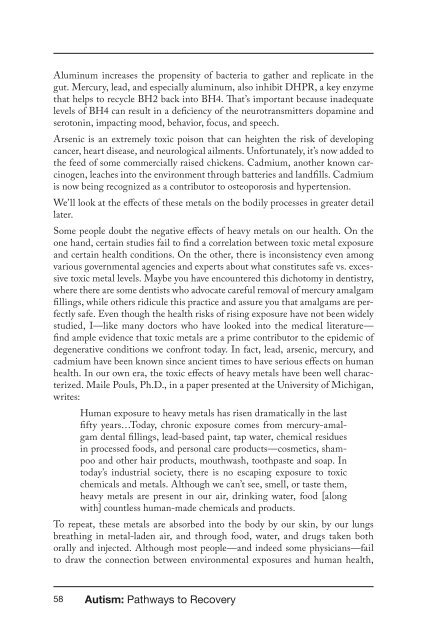3dT4E4Rnm
3dT4E4Rnm
3dT4E4Rnm
Create successful ePaper yourself
Turn your PDF publications into a flip-book with our unique Google optimized e-Paper software.
Aluminum increases the propensity of bacteria to gather and replicate in the<br />
gut. Mercury, lead, and especially aluminum, also inhibit DHPR, a key enzyme<br />
that helps to recycle BH2 back into BH4. That’s important because inadequate<br />
levels of BH4 can result in a deficiency of the neurotransmitters dopamine and<br />
serotonin, impacting mood, behavior, focus, and speech.<br />
Arsenic is an extremely toxic poison that can heighten the risk of developing<br />
cancer, heart disease, and neurological ailments. Unfortunately, it’s now added to<br />
the feed of some commercially raised chickens. Cadmium, another known carcinogen,<br />
leaches into the environment through batteries and landfills. Cadmium<br />
is now being recognized as a contributor to osteoporosis and hypertension.<br />
We’ll look at the effects of these metals on the bodily processes in greater detail<br />
later.<br />
Some people doubt the negative effects of heavy metals on our health. On the<br />
one hand, certain studies fail to find a correlation between toxic metal exposure<br />
and certain health conditions. On the other, there is inconsistency even among<br />
various governmental agencies and experts about what constitutes safe vs. excessive<br />
toxic metal levels. Maybe you have encountered this dichotomy in dentistry,<br />
where there are some dentists who advocate careful removal of mercury amalgam<br />
fillings, while others ridicule this practice and assure you that amalgams are perfectly<br />
safe. Even though the health risks of rising exposure have not been widely<br />
studied, I—like many doctors who have looked into the medical literature—<br />
find ample evidence that toxic metals are a prime contributor to the epidemic of<br />
degenerative conditions we confront today. In fact, lead, arsenic, mercury, and<br />
cadmium have been known since ancient times to have serious effects on human<br />
health. In our own era, the toxic effects of heavy metals have been well characterized.<br />
Maile Pouls, Ph.D., in a paper presented at the University of Michigan,<br />
writes:<br />
Human exposure to heavy metals has risen dramatically in the last<br />
fifty years…Today, chronic exposure comes from mercury-amalgam<br />
dental fillings, lead-based paint, tap water, chemical residues<br />
in processed foods, and personal care products—cosmetics, shampoo<br />
and other hair products, mouthwash, toothpaste and soap. In<br />
today’s industrial society, there is no escaping exposure to toxic<br />
chemicals and metals. Although we can’t see, smell, or taste them,<br />
heavy metals are present in our air, drinking water, food [along<br />
with] countless human-made chemicals and products.<br />
To repeat, these metals are absorbed into the body by our skin, by our lungs<br />
breathing in metal-laden air, and through food, water, and drugs taken both<br />
orally and injected. Although most people—and indeed some physicians—fail<br />
to draw the connection between environmental exposures and human health,<br />
58 Autism: Pathways to Recovery


